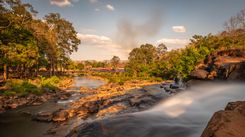A ghost of its former self, MUANG KHOUN, old Xieng Khuang, 35km southeast of Phonsavan, was once the royal seat of the minor kingdom Xieng Khuang, renowned in the sixteenth century for its 62 opulent stupas, whose sides were said to be covered in treasure. Years of bloody invasions by Thai and Vietnamese soldiers, pillaging by Chinese bandits in the nineteenth century and a monsoon of bombs that lasted nearly a decade during the Second Indochina War taxed this town so heavily that, by the time the air raids stopped, next to nothing was left of the kingdom’s exquisite temples. The town was all but abandoned, and centuries of history were drawn to a close. All that remains of the kingdom’s former glory is an elegant Buddha image towering over ruined columns of brick at Wat Phia Wat, and That Dam, both of which bear the scars of the events that ended Xieng Khuang’s centuries of rich history. Although the town has been rebuilt and renamed, it has taken a back seat to Phonsavan, and, with little in the way of amenities for travellers – there are a few fõe shops around the market, but no hotel – it’s most convenient to visit Muang Khoun as a day-trip.




